My homemade 3m parabolic radiotelescope
Mario M.
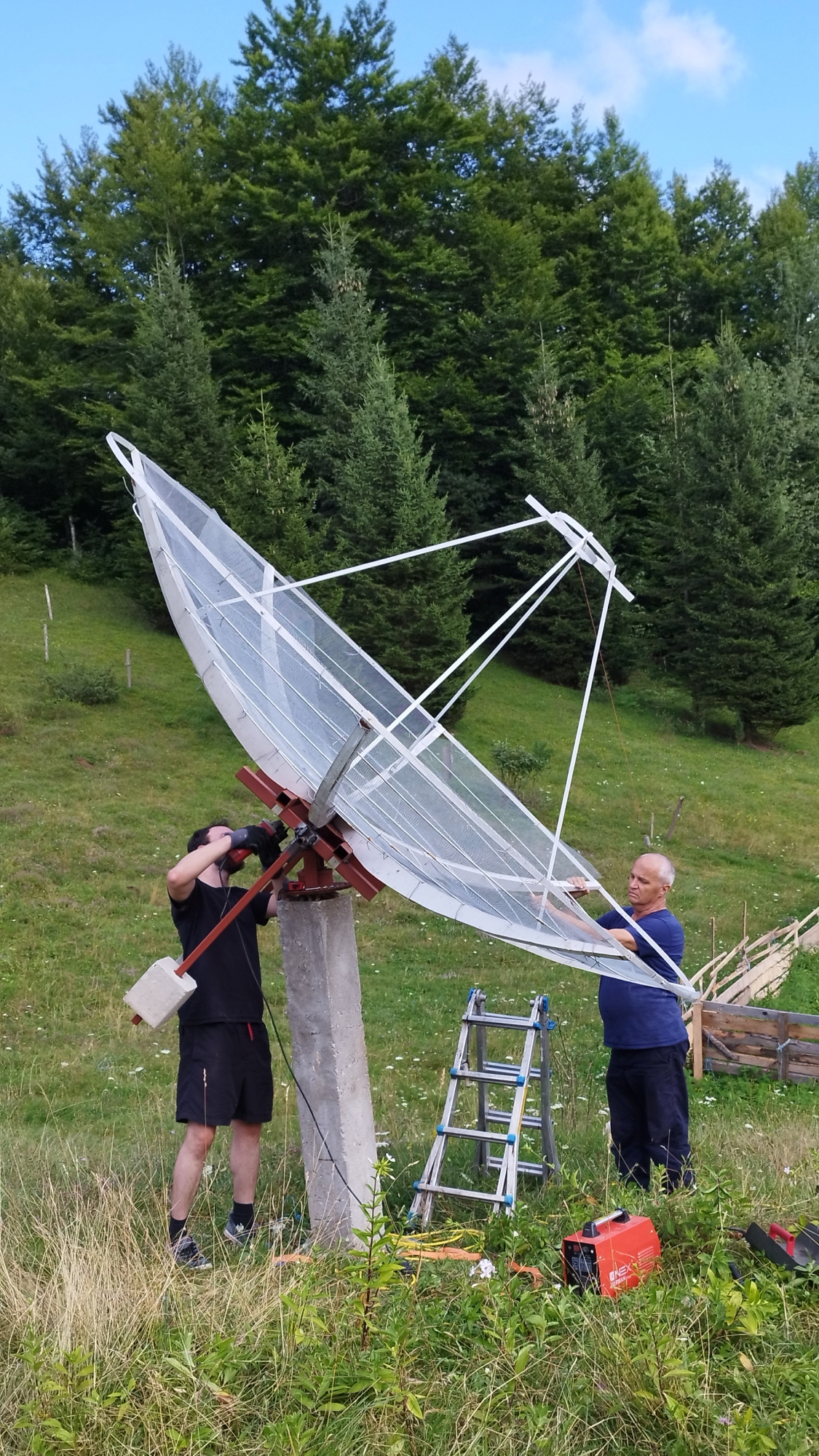
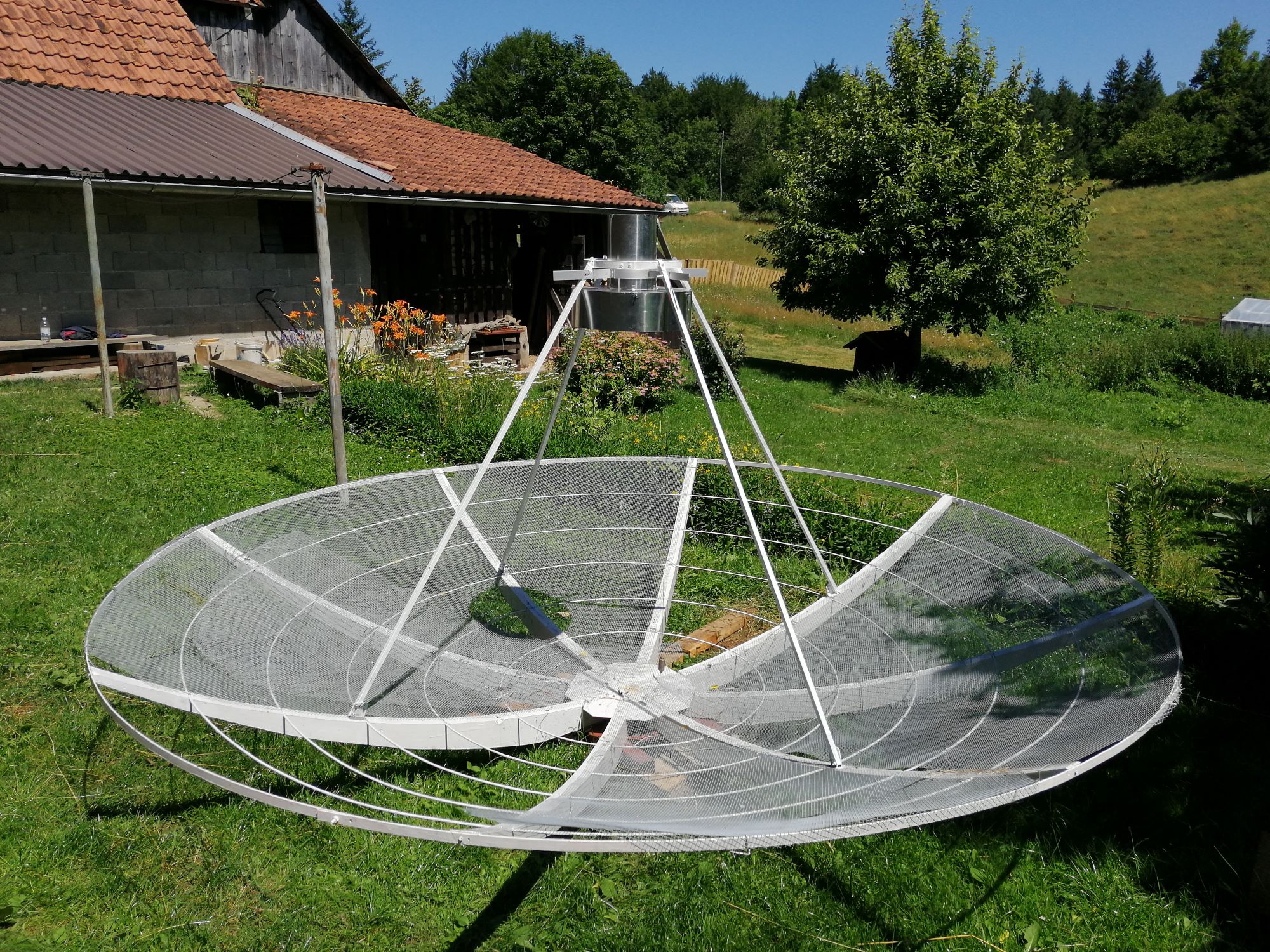
B & MR Randall
Your construction job is impressive. Hope ypu get feed and radio together soon
Bruce Randall
--
--
You received this message because you are subscribed to the Google
Groups "Society of Amateur Radio Astronomers" group.
To post to this group, send email to sara...@googlegroups.com
To unsubscribe from this group, send email to
sara-list-...@googlegroups.com
For more options, visit this group at
http://groups.google.com/group/sara-list?hl=en
---
You received this message because you are subscribed to the Google Groups "Society of Amateur Radio Astronomers" group.
To unsubscribe from this group and stop receiving emails from it, send an email to sara-list+...@googlegroups.com.
To view this discussion on the web visit https://groups.google.com/d/msgid/sara-list/4e687056-2c1d-4670-9235-0324d9fdf310n%40googlegroups.com.
Mathew George
--
Anthony
--
Mike
--
djl
Very Nice!
--
--
You received this message because you are subscribed to the Google
Groups "Society of Amateur Radio Astronomers" group.
To post to this group, send email to sara...@googlegroups.com
To unsubscribe from this group, send email to
sara-list-...@googlegroups.com
For more options, visit this group at
http://groups.google.com/group/sara-list?hl=en
---
You received this message because you are subscribed to the Google Groups "Society of Amateur Radio Astronomers" group.
To unsubscribe from this group and stop receiving emails from it, send an email to sara-list+...@googlegroups.com.
To view this discussion on the web visit https://groups.google.com/d/msgid/sara-list/4e687056-2c1d-4670-9235-0324d9fdf310n%40googlegroups.com.
"It's always something."
Roseanne Rosannadanna
----------------------"
Dr. Don Latham AJ7LL
PO Box 404, Frenchtown, MT, 59834
VOX: 406-626-4304
Michael Perkins
--
Alex P
Marcus D. Leech
Mario,
That is a fantastic job well done!We look forward to seeing more as your project progresses.
MichaelKB1PQS
To view this discussion on the web visit https://groups.google.com/d/msgid/sara-list/CACZunDa%3D4-oGvHZwcgNkaCUZ_0CTdBeza01pqfnkV3ghqmQAgg%40mail.gmail.com.
fasleitung3
Mario M.
Yes, the feedhorn is about 70% complete. I need to install the antenna and solder the aluminium parts and that's done. Then digging out and putting a electrical conduit in the ground. I think I'll get first light in about 1-2 months.
Mario M.
Lester Veenstra
Mario: Would you be willing to publish a drawing. I would particularly like to see how the mount was designed.
Thanks
Les
Lester B Veenstra K1YCM MØYCM W8YCM 6Y6Y W8YCM/6Y 6Y8LV (Reformed USNSG CTM1)
452 Stable Ln
Keyser WV 26726 USA
GPS: 39.336826 N 78.982287 W (Google)
GPS: 39.33682 N 78.9823741 W (GPSDO)
Telephones:
Home: +1-304-289-6057
US cell +1-304-790-9192
Jamaica cell: +1-876-456-8898
To view this discussion on the web visit https://groups.google.com/d/msgid/sara-list/e10b751b-85ae-345f-dc78-e8c97c490904%40gmail.com.
Mario M.

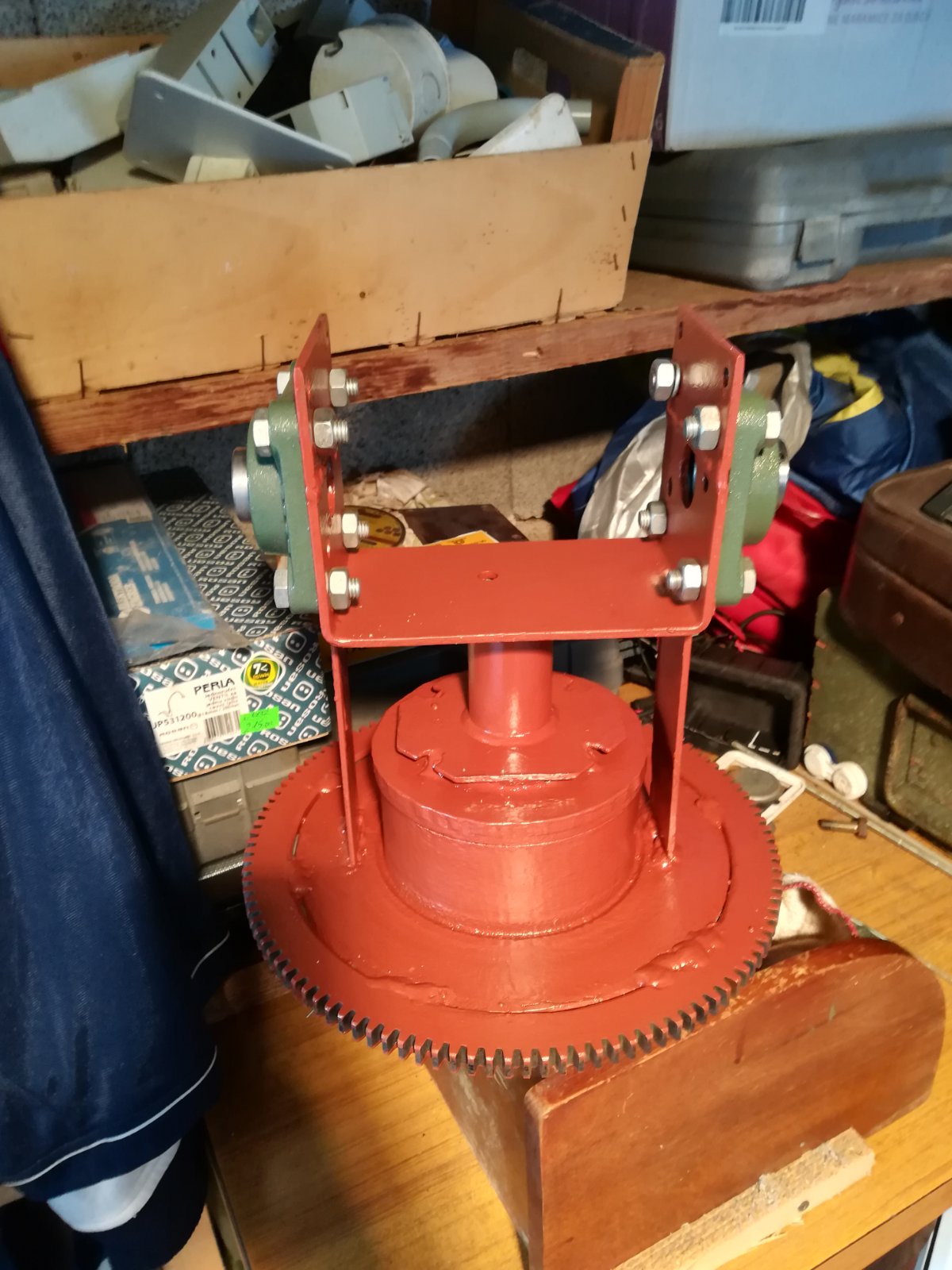

Lester Veenstra
Thanks
Lester B Veenstra K1YCM MØYCM W8YCM 6Y6Y W8YCM/6Y 6Y8LV (Reformed USNSG CTM1)
452 Stable Ln
Keyser WV 26726 USA
GPS: 39.336826 N 78.982287 W (Google)
GPS: 39.33682 N 78.9823741 W (GPSDO)
Telephones:
Home: +1-304-289-6057
US cell +1-304-790-9192
Jamaica cell: +1-876-456-8898
From: sara...@googlegroups.com [mailto:sara...@googlegroups.com] On Behalf Of Mario M.
Sent: Saturday, August 12, 2023 10:13 AM
To: Society of Amateur Radio Astronomers
Subject: Re: [SARA] My homemade 3m parabolic radiotelescope
I don't really have a drawing, but I do have some close up photos. The base for the mount was the bearing from the car wheel. On top came a steel holder for a wooden pillars, and on it I put some other regular bearings for another axis. There's a cog wheel for future, when I put motors on it.
--
--
You received this message because you are subscribed to the Google
Groups "Society of Amateur Radio Astronomers" group.
To post to this group, send email to sara...@googlegroups.com
To unsubscribe from this group, send email to
sara-list-...@googlegroups.com
For more options, visit this group at
http://groups.google.com/group/sara-list?hl=en
---
You received this message because you are subscribed to the Google Groups "Society of Amateur Radio Astronomers" group.
To unsubscribe from this group and stop receiving emails from it, send an email to sara-list+...@googlegroups.com.
To view this discussion on the web visit https://groups.google.com/d/msgid/sara-list/f63bb6a7-3108-4273-a284-39ef8d69f91fn%40googlegroups.com.
Dimitry UA3AVR
b alex pettit jr
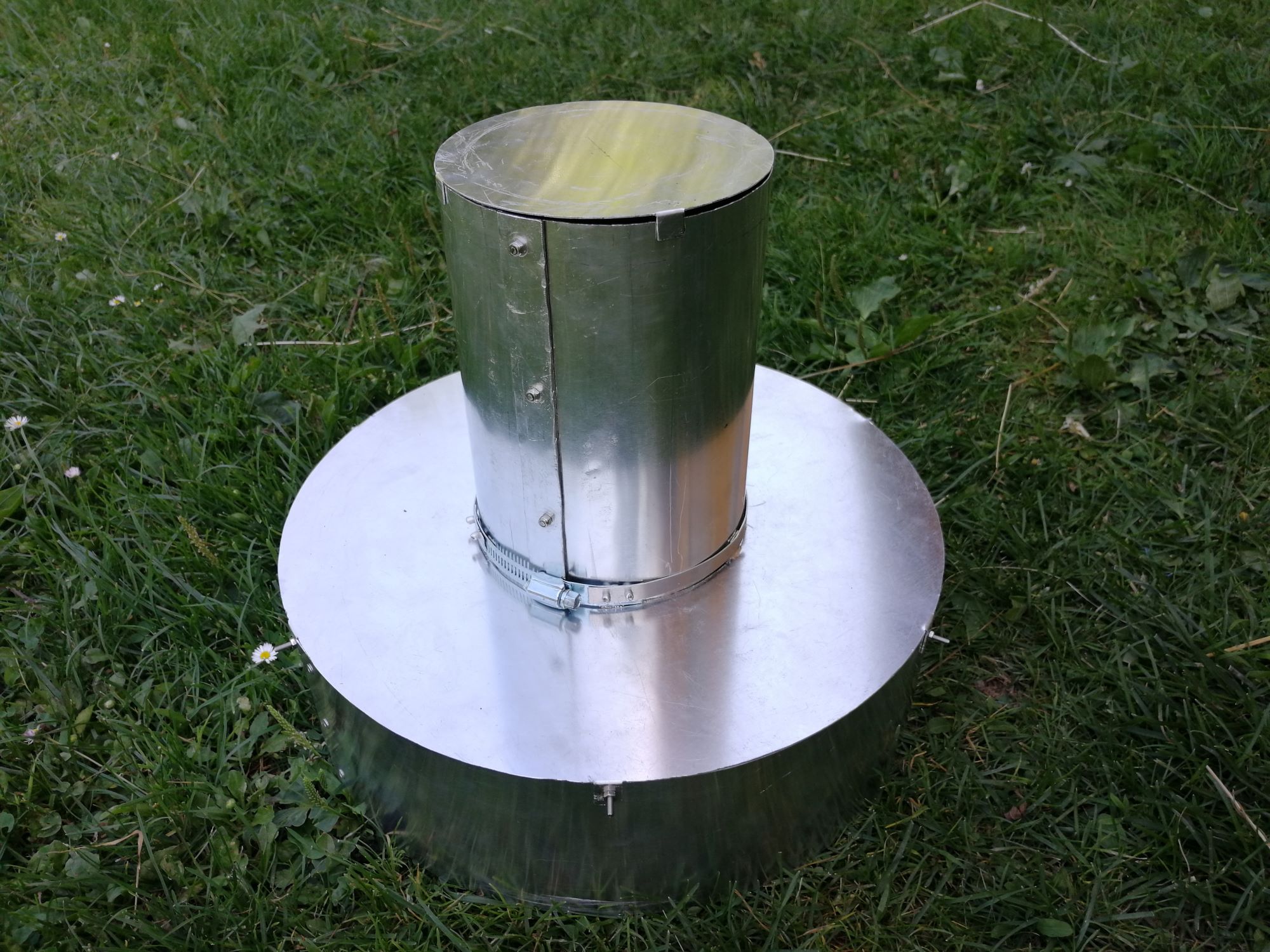
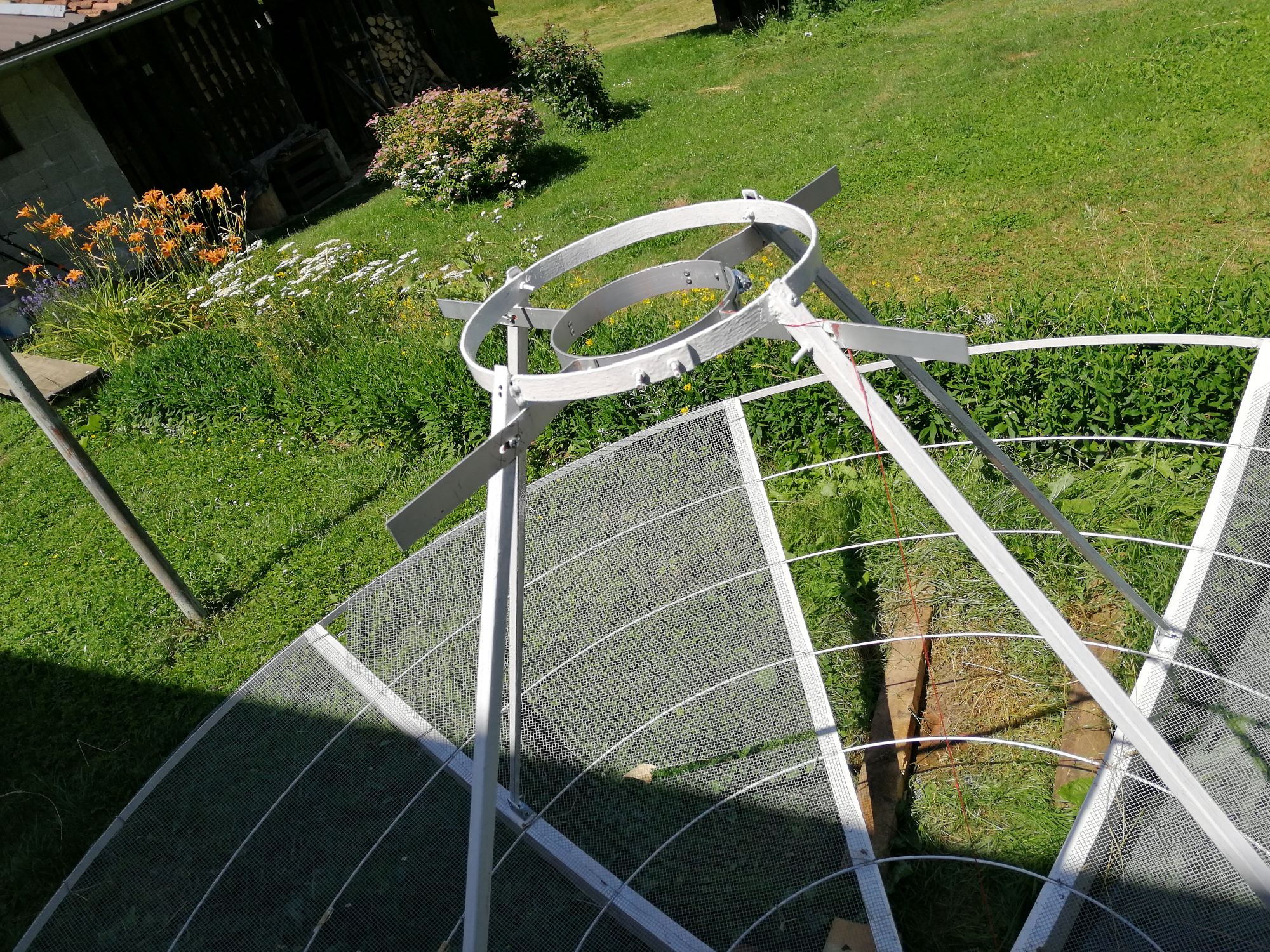
Eduard Mol
Mario M.
b alex pettit jr

Nathaniel Butts
Mario M.
Mario M.
Eduard Mol
--
--
You received this message because you are subscribed to the Google
Groups "Society of Amateur Radio Astronomers" group.
To post to this group, send email to sara...@googlegroups.com
To unsubscribe from this group, send email to
sara-list-...@googlegroups.com
For more options, visit this group at
http://groups.google.com/group/sara-list?hl=en
---
You received this message because you are subscribed to the Google Groups "Society of Amateur Radio Astronomers" group.
To unsubscribe from this group and stop receiving emails from it, send an email to sara-list+...@googlegroups.com.
To view this discussion on the web visit https://groups.google.com/d/msgid/sara-list/803f1578-b522-4d1f-98d5-3784f1e14e08n%40googlegroups.com.
b alex pettit jr



Larry Mayfield
Alex, great idea regards the loop antenna. I’m gonna make one!
But will make it so that I can use the actual hardware in the system so that I will hopefully know how the system works together and then for bad places, and then I can do to experiment to reduce the RFI.
Sound?
Larry
Pahrump
From: 'b alex pettit jr' via Society of Amateur Radio Astronomers <sara...@googlegroups.com>
Sent: Sunday, August 13, 2023 3:19 AM
To: sara...@googlegroups.com
Subject: Re: [SARA] My homemade 3m parabolic radiotelescope
Hi Mario,
--
--
You received this message because you are subscribed to the Google
Groups "Society of Amateur Radio Astronomers" group.
To post to this group, send email to sara...@googlegroups.com
To unsubscribe from this group, send email to
sara-list-...@googlegroups.com
For more options, visit this group at
http://groups.google.com/group/sara-list?hl=en
---
You received this message because you are subscribed to the Google Groups "Society of Amateur Radio Astronomers" group.
To unsubscribe from this group and stop receiving emails from it, send an email to sara-list+...@googlegroups.com.
To view this discussion on the web visit https://groups.google.com/d/msgid/sara-list/1316765407.2029759.1691921969573%40mail.yahoo.com.
Douglas Decker
I like Alex had to do some extending. Some information that may
help others.

The above shows my rough one line.
Systems working fine.

--
--
You received this message because you are subscribed to the Google
Groups "Society of Amateur Radio Astronomers" group.
To post to this group, send email to sara...@googlegroups.com
To unsubscribe from this group, send email to
sara-list-...@googlegroups.com
For more options, visit this group at
http://groups.google.com/group/sara-list?hl=en
---
You received this message because you are subscribed to the Google Groups "Society of Amateur Radio Astronomers" group.
To unsubscribe from this group and stop receiving emails from it, send an email to sara-list+...@googlegroups.com.
To view this discussion on the web visit https://groups.google.com/d/msgid/sara-list/441321740.1958088.1691870738948%40mail.yahoo.com.
Marcus D. Leech
I like Alex had to do some extending. Some information that may help others.
The above shows my rough one line.
Systems working fine.

only have a few m of cable between the LNA output and the receiver. Then carry your ethernet connection from the
computer via fiber -- 1Gig fiber bridges are now fairly cheap. Aggressively decouple the power feed going into the
computer box and make sure your fiber goes through the smallest possible hole in the shielded box.
We sorta-kinda use this at the CCERA observatory in Carp, ON. The LNAs are at the feedpoint, then there's about 10m
of cable that feeds our 4-channel SDR in the elevation cabin behind the dish, then a 10G fiber going to our computer
downstairs.
To view this discussion on the web visit https://groups.google.com/d/msgid/sara-list/5140c1c8-a6a6-a041-8bf0-fbdad1d52dce%40gmail.com.
Mario M.
Nathaniel Butts
--
--
You received this message because you are subscribed to the Google
Groups "Society of Amateur Radio Astronomers" group.
To post to this group, send email to sara...@googlegroups.com
To unsubscribe from this group, send email to
sara-list-...@googlegroups.com
For more options, visit this group at
http://groups.google.com/group/sara-list?hl=en
---
You received this message because you are subscribed to a topic in the Google Groups "Society of Amateur Radio Astronomers" group.
To unsubscribe from this topic, visit https://groups.google.com/d/topic/sara-list/IC5sHGIZ6Io/unsubscribe.
To unsubscribe from this group and all its topics, send an email to sara-list+...@googlegroups.com.
To view this discussion on the web visit https://groups.google.com/d/msgid/sara-list/4ae9ec54-449a-4b38-a3e5-fecce76e6a6en%40googlegroups.com.
b alex pettit jr
Mario M.
Mario M.
Mathew George
You received this message because you are subscribed to the Google Groups "Society of Amateur Radio Astronomers" group.
To unsubscribe from this group and stop receiving emails from it, send an email to sara-list+...@googlegroups.com.
To view this discussion on the web visit https://groups.google.com/d/msgid/sara-list/58cf81b1-44c6-4001-9ce4-9fd4e978d45cn%40googlegroups.com.
mike....@gmail.com
2) Thermal Mass, large metal heat sinks or just metal bars or water bottles
b alex pettit jr


Lester Veenstra
https://spaceweatherarchive.com/2023/08/15/ham-radio-operators-hack-a-nasa-spacecraft/
Lester B Veenstra K1YCM MØYCM W8YCM 6Y6Y W8YCM/6Y 6Y8LV (Reformed USNSG CTM1)
452 Stable Ln
Keyser WV 26726 USA
GPS: 39.336826 N 78.982287 W (Google)
GPS: 39.33682 N 78.9823741 W (GPSDO)
Telephones:
Home: +1-304-289-6057
US cell +1-304-790-9192
Jamaica cell: +1-876-456-8898
.
fasleitung3
tedcl...@gmail.com
Ted Cline N0RQV
fasleitung3
--
--
You received this message because you are subscribed to the Google
Groups "Society of Amateur Radio Astronomers" group.
To post to this group, send email to sara...@googlegroups.com
To unsubscribe from this group, send email to
sara-list-...@googlegroups.com
For more options, visit this group at
http://groups.google.com/group/sara-list?hl=en
---
You received this message because you are subscribed to the Google Groups "Society of Amateur Radio Astronomers" group.
To unsubscribe from this group and stop receiving emails from it, send an email to sara-list+...@googlegroups.com.
To view this discussion on the web visit https://groups.google.com/d/msgid/sara-list/def95bc0-0a40-4190-bb28-3386579142fdn%40googlegroups.com.
Marcus D. Leech
Ted, what is your reference then?Wolfgang
(A) Very stable with temperature
(B) Producing a noise temp that is comparable to the observed Tant
They don't do that well in providing gain stabilization.
To view this discussion on the web visit https://groups.google.com/d/msgid/sara-list/94aa4bf939190aeaa140e5f6754d3a5a8023e642.camel%40googlemail.com.
fasleitung3
tedcl...@gmail.com
djl
Is that like a tribble?
--
--
You received this message because you are subscribed to the Google
Groups "Society of Amateur Radio Astronomers" group.
To post to this group, send email to sara...@googlegroups.com
To unsubscribe from this group, send email to
sara-list-...@googlegroups.com
For more options, visit this group at
http://groups.google.com/group/sara-list?hl=en
---
You received this message because you are subscribed to the Google Groups "Society of Amateur Radio Astronomers" group.
To unsubscribe from this group and stop receiving emails from it, send an email to sara-list+...@googlegroups.com.
To view this discussion on the web visit https://groups.google.com/d/msgid/sara-list/02c301d9d04d%248fcf3180%24af6d9480%24%40com.
"It's always something."
Roseanne Rosannadanna
----------------------"
Dr. Don Latham AJ7LL
PO Box 404, Frenchtown, MT, 59834
VOX: 406-626-4304
Mario M.
matovin...@gmail.com


Marcus D. Leech
see half of that. The Sun occupies about 1/100th of your
beam area with a 3m dish. So, 50,000 / 100 is about 500K Tant, so a
roughly 10dB rise, given a good LNA is about right.
Keep in mind that the hydrogen spectrum will cause, at most, a 2dB
"bump" in the spectrum. Make sure you're integrating
for long enough (a few 10s of seconds), and that you have your
spectral display scaled appropriately.
Mario
Marcus D. Leech
I may have made a big mistake. I didn't integrate the signal at all. I just turned on SDR sharp and looked at the signal and expected to see it there...
--
--
You received this message because you are subscribed to the Google
Groups "Society of Amateur Radio Astronomers" group.
To post to this group, send email to sara...@googlegroups.com
To unsubscribe from this group, send email to
sara-list-...@googlegroups.com
For more options, visit this group at
http://groups.google.com/group/sara-list?hl=en
---
You received this message because you are subscribed to the Google Groups "Society of Amateur Radio Astronomers" group.
To unsubscribe from this group and stop receiving emails from it, send an email to sara-list+...@googlegroups.com.
To view this discussion on the web visit https://groups.google.com/d/msgid/sara-list/113a9a29-a60c-4f59-ad34-8ce94e4a9465n%40googlegroups.com.
Nathaniel Butts
--
--
You received this message because you are subscribed to the Google
Groups "Society of Amateur Radio Astronomers" group.
To post to this group, send email to sara...@googlegroups.com
To unsubscribe from this group, send email to
sara-list-...@googlegroups.com
For more options, visit this group at
http://groups.google.com/group/sara-list?hl=en
---
You received this message because you are subscribed to a topic in the Google Groups "Society of Amateur Radio Astronomers" group.
To unsubscribe from this topic, visit https://groups.google.com/d/topic/sara-list/IC5sHGIZ6Io/unsubscribe.
To unsubscribe from this group and all its topics, send an email to sara-list+...@googlegroups.com.
To view this discussion on the web visit https://groups.google.com/d/msgid/sara-list/113a9a29-a60c-4f59-ad34-8ce94e4a9465n%40googlegroups.com.
Anthony
To view this discussion on the web visit https://groups.google.com/d/msgid/sara-list/51cf402d-664d-4cac-a934-635228e7dcb5%40gmail.com.
Eduard Mol

To view this discussion on the web visit https://groups.google.com/d/msgid/sara-list/CAKU65Tz2u-nPVZCAFuD%3DhWeex5G95JRGMfEFBFpu5SaC3PryNw%40mail.gmail.com.
Mario
Mario
Eduard Mol
You received this message because you are subscribed to a topic in the Google Groups "Society of Amateur Radio Astronomers" group.
To unsubscribe from this topic, visit https://groups.google.com/d/topic/sara-list/IC5sHGIZ6Io/unsubscribe.
To unsubscribe from this group and all its topics, send an email to sara-list+...@googlegroups.com.
To view this discussion on the web visit https://groups.google.com/d/msgid/sara-list/987dc094-f70e-47a3-acb8-6d577d06353dn%40googlegroups.com.
Mario
Eduard Mol
To view this discussion on the web visit https://groups.google.com/d/msgid/sara-list/10503642-4f53-43e5-946a-e7b7ea82009fn%40googlegroups.com.
Andrew Thornett
Sent: Monday, October 9, 2023 12:08:29 PM
To: sara...@googlegroups.com <sara...@googlegroups.com>
Subject: Re: [SARA] My homemade 3m parabolic radiotelescope
Andrew Thornett
Sent: Monday, October 9, 2023 1:13:00 PM
Mario
Andrew Thornett
Sent: Monday, October 9, 2023 2:20:10 PM
To: Society of Amateur Radio Astronomers <sara...@googlegroups.com>
Mario
fasleitung3
Nathaniel Butts

--
--
You received this message because you are subscribed to the Google
Groups "Society of Amateur Radio Astronomers" group.
To post to this group, send email to sara...@googlegroups.com
To unsubscribe from this group, send email to
sara-list-...@googlegroups.com
For more options, visit this group at
http://groups.google.com/group/sara-list?hl=en
---
You received this message because you are subscribed to a topic in the Google Groups "Society of Amateur Radio Astronomers" group.
To unsubscribe from this topic, visit https://groups.google.com/d/topic/sara-list/IC5sHGIZ6Io/unsubscribe.
To unsubscribe from this group and all its topics, send an email to sara-list+...@googlegroups.com.
To view this discussion on the web visit https://groups.google.com/d/msgid/sara-list/24560164aefc26535db83ed84558ac900b8be4b1.camel%40googlemail.com.
Mario
Mario
Alex P
Andrew Thornett
Sent: Tuesday, October 10, 2023 11:32:48 AM
To: Society of Amateur Radio Astronomers <sara...@googlegroups.com>
Subject: Re: [SARA] My homemade 3m parabolic radiotelescope
--
You received this message because you are subscribed to the Google
Groups "Society of Amateur Radio Astronomers" group.
To post to this group, send email to sara...@googlegroups.com
To unsubscribe from this group, send email to
sara-list-...@googlegroups.com
For more options, visit this group at
http://groups.google.com/group/sara-list?hl=en
---
To view this discussion on the web visit https://groups.google.com/d/msgid/sara-list/ab2f46ea-b775-47c0-b4da-eb94c1a1b164n%40googlegroups.com.
Mario

b alex pettit jr

Mario
b alex pettit jr
Mathew George
To view this discussion on the web visit https://groups.google.com/d/msgid/sara-list/bd8ad2e6-53cd-4292-b6ea-1b6635d7046en%40googlegroups.com.
Marcus D. Leech
Simply covering the feedhorn with aluminium foil or suitable metallic lid, should make the peak disappear. This can be a confirmatory test.
destructively. Because a short across the waveguide constitutes and profound impedance-mismatch.
To view this discussion on the web visit https://groups.google.com/d/msgid/sara-list/CAD8cUAnL9VqAD%3Dj5gpC4ZndoHxv5fRjV3MKEw%2BY65sG4tu4R6g%40mail.gmail.com.
Mario


fasleitung3
b alex pettit jr
-
b alex pettit jr
fasleitung3
--
--
You received this message because you are subscribed to the Google
Groups "Society of Amateur Radio Astronomers" group.
To post to this group, send email to sara...@googlegroups.com
To unsubscribe from this group, send email to
sara-list-...@googlegroups.com
For more options, visit this group at
http://groups.google.com/group/sara-list?hl=en
---
You received this message because you are subscribed to the Google Groups "Society of Amateur Radio Astronomers" group.
To unsubscribe from this group and stop receiving emails from it, send an email to sara-list+...@googlegroups.com.
To view this discussion on the web visit https://groups.google.com/d/msgid/sara-list/1636363356.742486.1699523740871%40mail.yahoo.com.
Mario
b alex pettit jr
Mario
Alex P
Mario

b alex pettit jr

Mario
fasleitung3
Any ideas on how to protect LNA from rain and other weather? I thought about putting it in a waterproof box and then on the feedhorn, but then I have a problem of sealing the box around the hole for the antenna connector...
--
--
You received this message because you are subscribed to the Google
Groups "Society of Amateur Radio Astronomers" group.
To post to this group, send email to sara...@googlegroups.com
To unsubscribe from this group, send email to
sara-list-...@googlegroups.com
For more options, visit this group at
http://groups.google.com/group/sara-list?hl=en
---
You received this message because you are subscribed to the Google Groups "Society of Amateur Radio Astronomers" group.
To unsubscribe from this group and stop receiving emails from it, send an email to sara-list+...@googlegroups.com.
To view this discussion on the web visit https://groups.google.com/d/msgid/sara-list/1d03655d-d32a-4373-a247-db7e4dbdaa78n%40googlegroups.com.
Mario
fasleitung3
designed to be used outside. SMA-Connectors are intended for indoor
use.
Wolfgang
Mario
b alex pettit jr



Mario
Mario



Anthony
--
--
You received this message because you are subscribed to the Google
Groups "Society of Amateur Radio Astronomers" group.
To post to this group, send email to sara...@googlegroups.com
To unsubscribe from this group, send email to
sara-list-...@googlegroups.com
For more options, visit this group at
http://groups.google.com/group/sara-list?hl=en
---
You received this message because you are subscribed to the Google Groups "Society of Amateur Radio Astronomers" group.
To unsubscribe from this group and stop receiving emails from it, send an email to sara-list+...@googlegroups.com.
To view this discussion on the web visit https://groups.google.com/d/msgid/sara-list/777d552e-e92e-4ae1-97e1-460c0030762en%40googlegroups.com.
Clint Jeffrey
Cheers
Clint - VK3CSJ
On Mon, Feb 5, 2024 at 5:25 PM Mario <matovin...@gmail.com<mailto:matovin...@gmail.com>> wrote:
First light of the telescope:
Feedhorn, LNA and SDR receiver were finally placed on the radio telescope.
It was pointed to about 45 Alt, 202 Azimuth. It's also temporary setup because I need some new connectors and cable. Don't pay attention to that wooden fence, it's temporary and I will make it wider later.
First thing I noticed were that there are some peaks in the graph, my guess is that they are from some source. Wifi amplifier or maybe SDR receiver that's placed right under the dish. This was the result of about an hour of Milky way crossing the field of view



